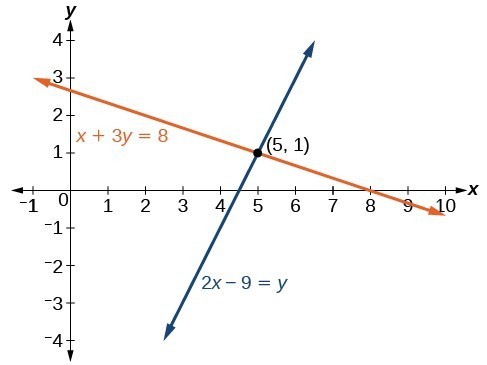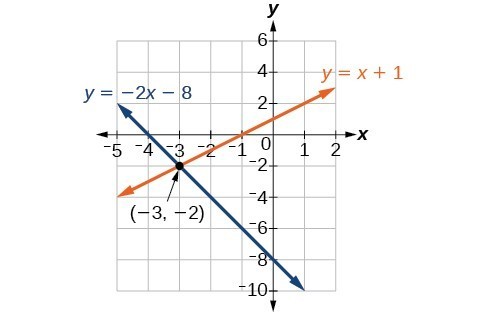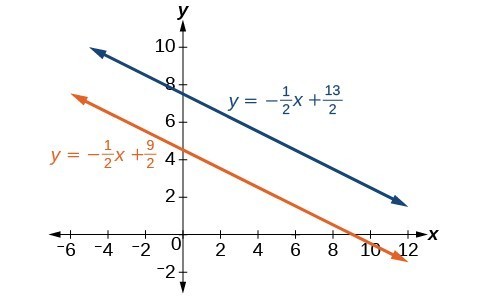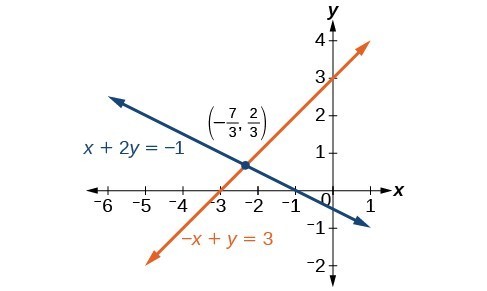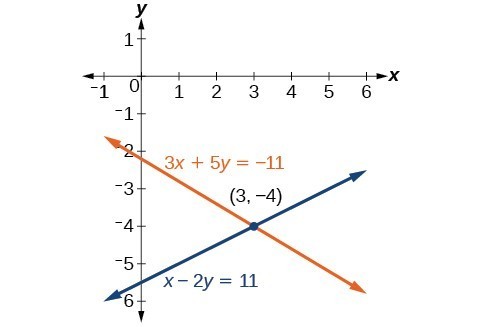Learning Objectives
- (5.1.1) – Define and classify solutions to systems of linear equations
- Determine whether an ordered pair is a solution to a system of linear equations
- (5.1.2) – Solve a system of linear equations by graphing
- (5.1.3) – Solve a system of linear equations by substitution
- (5.1.4) – Solve a system of linear equations using the addition method
- (5.1.5) – Classifying solutions to a system; inconsistent and dependent systems
- Recognize consistent and inconsistent, dependent and independent systems of linear equations
(5.1.1) – Define and classify solutions to systems of linear equations
A system of linear equations consists of two or more linear equations made up of two or more variables such that all equations in the system are considered simultaneously. To find the unique solution to a system of linear equations, we must find a numerical value for each variable in the system that will satisfy all equations in the system at the same time. Some linear systems may not have a solution and others may have an infinite number of solutions. In order for a linear system to have a unique solution, there must be at least as many equations as there are variables. Even so, this does not guarantee a unique solution.
In this section, we will look at systems of linear equations in two variables, which consist of two equations that contain two different variables. For example, consider the following system of linear equations in two variables.
The solution to a system of linear equations in two variables is any ordered pair that satisfies each equation independently. In this example, the ordered pair (4, 7) is the solution to the system of linear equations. We can verify the solution by substituting the values into each equation to see if the ordered pair satisfies both equations. Shortly we will investigate methods of finding such a solution if it exists.
In addition to considering the number of equations and variables, we can categorize systems of linear equations by the number of solutions. A consistent system of equations has at least one solution. A consistent system is considered to be an independent system if it has a single solution, such as the example we just explored. The two lines have different slopes and intersect at one point in the plane. A consistent system is considered to be a dependent system if the equations have the same slope and the same y-intercepts. In other words, the lines coincide so the equations represent the same line. Every point on the line represents a coordinate pair that satisfies the system. Thus, there are an infinite number of solutions.
Another type of system of linear equations is an inconsistent system, which is one in which the equations represent two parallel lines. The lines have the same slope and different y-intercepts. There are no points common to both lines; hence, there is no solution to the system.
A General Note: Types of Linear Systems
There are three types of systems of linear equations in two variables, and three types of solutions.
- An independent system has exactly one solution pair [latex]\left(x,y\right)[/latex]. The point where the two lines intersect is the only solution.
- An inconsistent system has no solution. Notice that the two lines are parallel and will never intersect.
- A dependent system has infinitely many solutions. The lines are coincident. They are the same line, so every coordinate pair on the line is a solution to both equations.
Below are graphical representations of each type of system.

The independent and dependent systems are also consistent because they both have at least one solution.
How To: Given a system of linear equations and an ordered pair, determine whether the ordered pair is a solution.
- Substitute the ordered pair into each equation in the system.
- Determine whether true statements result from the substitution in both equations; if so, the ordered pair is a solution.
Example
Determine whether the ordered pair [latex]\left(5,1\right)[/latex] is a solution to the given system of equations.
In the following video we will show another example of how to verify whether an ordered pair is a solution to a system of equations.
(5.1.2) – Solve a system of linear equations by graphing
There are multiple methods of solving systems of linear equations. For a system of linear equations in two variables, we can determine both the type of system and the solution by graphing the system of equations on the same set of axes.
Example
Solve the following system of equations by graphing. Identify the type of system.
[latex]\begin{array}{c}2x+y=-8\\ x-y=-1\end{array}[/latex]
Graphing can be used if the system is inconsistent or dependent. In both cases we can still graph the system to determine the type of system and solution. If the two lines are parallel, the system has no solution and is inconsistent. If the two lines are identical, the system has infinite solutions and is a dependent system.
In the following video we show another example of how to identify whether a graphed system has a solution, and identify what type of solution is represented.
In our last video we show how to solve a system of equations by first graphing the lines, then identifying the type of solution the system has.
(5.1.3) – Solve a system of linear equations by substitution
Solving a linear system in two variables by graphing works well when the solution consists of integer values, but if our solution contains decimals or fractions, it is not the most precise method. We will consider two more methods of solving a system of linear equations that are more precise than graphing. One such method is solving a system of equations by the substitution method, in which we solve one of the equations for one variable and then substitute the result into the second equation to solve for the second variable. Recall that we can solve for only one variable at a time, which is the reason the substitution method is both valuable and practical.
How To: Given a system of two equations in two variables, solve using the substitution method.
- Solve one of the two equations for one of the variables in terms of the other.
- Substitute the expression for this variable into the second equation, then solve for the remaining variable.
- Substitute that solution into either of the original equations to find the value of the first variable. If possible, write the solution as an ordered pair.
- Check the solution in both equations.
Example
Solve the following system of equations by substitution.
In the following video, you will be given an example of solving a systems of two equations using the substitution method.
If you had chosen the other equation to start with in the previous example, you would still be able to find the same solution. It is really a matter of preference because sometimes solving for a variable will result in having to work with fractions. As you become more experienced with algebra, you will be able to anticipate what choices will lead to more desirable outcomes.
Recall that an inconsistent system consists of parallel lines that have the same slope but different y-intercepts. They will never intersect. When searching for a solution to an inconsistent system, we will come up with a false statement, such as [latex]12=0[/latex].
Example
Solve the following system of equations.
[latex]\begin{array}{l}\text{ }x=9 - 2y\hfill \\ x+2y=13\hfill \end{array}[/latex]
In the next video we show another example of using substitution to solve a system that has no solution.
In our next video we show that a system can have an infinite number of solutions.
(5.1.4) – Solve a system of linear equations using the addition method
A third method of solving systems of linear equations is the addition method, this method is also called the elimination method. In this method, we add two terms with the same variable, but opposite coefficients, so that the sum is zero. Of course, not all systems are set up with the two terms of one variable having opposite coefficients. Often we must adjust one or both of the equations by multiplication so that one variable will be eliminated by addition.
How To: Given a system of equations, solve using the addition method.
- Write both equations with x– and y-variables on the left side of the equal sign and constants on the right.
- Write one equation above the other, lining up corresponding variables. If one of the variables in the top equation has the opposite coefficient of the same variable in the bottom equation, add the equations together, eliminating one variable. If not, use multiplication by a nonzero number so that one of the variables in the top equation has the opposite coefficient of the same variable in the bottom equation, then add the equations to eliminate the variable.
- Solve the resulting equation for the remaining variable.
- Substitute that value into one of the original equations and solve for the second variable.
- Check the solution by substituting the values into the other equation.
Example: Solving a System by the Addition Method
Solve the given system of equations by addition.
[latex]\begin{array}{l}x+2y=-1\hfill \\ -x+y=3\hfill \end{array}[/latex]
Try IT
Example: Using the Addition Method When Multiplication of One Equation Is Required
Solve the given system of equations by the addition method.
[latex]\begin{array}{l}3x+5y=-11\hfill \\ \hfill \\ x - 2y=11\hfill \end{array}[/latex]
Try It
Solve the system of equations by addition.
[latex]\begin{array}{c}2x - 7y=2\\ 3x+y=-20\end{array}[/latex]
Example: Using the Addition Method When Multiplication of Both Equations Is Required
Solve the given system of equations in two variables by addition.
[latex]\begin{array}{c}2x+3y=-16\\ 5x - 10y=30\end{array}[/latex]
Example: Using the Addition Method in Systems of Equations Containing Fractions
Solve the given system of equations in two variables by addition.
[latex]\begin{array}{l}\frac{x}{3}+\frac{y}{6}=3\hfill \\ \frac{x}{2}-\frac{y}{4}=\text{ }1\hfill \end{array}[/latex]
Try It
Solve the system of equations by addition.
[latex]\begin{array}{c}2x+3y=8\\ 3x+5y=10\end{array}[/latex]
in the following video we present more examples of how to use the addition (elimination) method to solve a system of two linear equations.
(5.1.5) – Classifying solutions to a system; inconsistent and dependent systems
Now that we have several methods for solving systems of equations, we can use the methods to identify inconsistent systems. Recall that an inconsistent system consists of parallel lines that have the same slope but different [latex]y[/latex] -intercepts. They will never intersect. When searching for a solution to an inconsistent system, we will come up with a false statement, such as [latex]12=0[/latex].
Example: Solving an Inconsistent System of Equations
Solve the following system of equations.
[latex]\begin{array}{l}\text{ }x=9 - 2y\hfill \\ x+2y=13\hfill \end{array}[/latex]
Try It
Solve the following system of equations in two variables.
[latex]\begin{array}{l}2y - 2x=2\\ 2y - 2x=6\end{array}[/latex]
Expressing the Solution of a System of Dependent Equations Containing Two Variables
Recall that a dependent system of equations in two variables is a system in which the two equations represent the same line. Dependent systems have an infinite number of solutions because all of the points on one line are also on the other line. After using substitution or addition, the resulting equation will be an identity, such as [latex]0=0[/latex].
Example: Finding a Solution to a Dependent System of Linear Equations
Find a solution to the system of equations using the addition method.
[latex]\begin{array}{c}x+3y=2\\ 3x+9y=6\end{array}[/latex]
Writing the general solution
In the previous example, we presented an analysis of the solution to the following system of equations:
[latex]\begin{array}{c}x+3y=2\\ 3x+9y=6\end{array}[/latex]
After a little algebra, we found that these two equations were exactly the same. We then wrote the general solution as [latex]\left(x, -\frac{1}{3}x+\frac{2}{3}\right)[/latex]. Why would we write the solution this way? In some ways, this representation tells us a lot. It tells us that x can be anything, x is x. It also tells us that y is going to depend on x, just like when we write a function rule. In this case, depending on what you put in for x, y will be defined in terms of x as [latex]-\frac{1}{3}x+\frac{2}{3}[/latex].
In other words, there are infinitely many (x,y) pairs that will satisfy this system of equations, and they all fall on the line [latex]y=-\frac{1}{3}x+\frac{2}{3}[/latex].
Try It
Solve the following system of equations in two variables.
[latex]\begin{array}{l}\begin{array}{l}\\ \text{ }\text{}\text{}y - 2x=5\end{array}\hfill \\ -3y+6x=-15\hfill \end{array}[/latex]
In the following video we show another example of solving a system that is dependent using elimination (addition).
In our last video example we present a system that is inconsistent – it has no solutions which means the lines the equations represent are parallel to each other.
Candela Citations
- Determine if an Ordered Pair is a Solution to a System of Linear Equations. Authored by: James Sousa (Mathispower4u.com) for Lumen Learning. Located at: https://youtu.be/2IxgKgjX00k. License: CC BY: Attribution
- Determine the Number of Solutions to a System of Linear Equations From a Graph. Authored by: James Sousa (Mathispower4u.com) for Lumen Learning. Located at: https://youtu.be/ZolxtOjcEQY. License: CC BY: Attribution
- Ex 2: Solve a System of Equations Using the Elimination Method. Authored by: James Sousa (Mathispower4u.com) . Located at: https://youtu.be/_liDhKops2w. License: CC BY: Attribution
- Ex 2: Solve a System of Equations by Graphing. Authored by: James Sousa (Mathispower4u.com) . Located at: https://youtu.be/Lv832rXAQ5k. License: CC BY: Attribution
- Ex 2: Solve a System of Equations Using Substitution. Authored by: James Sousa (Mathispower4u.com) . Located at: https://youtu.be/MIXL35YRzRw. License: CC BY: Attribution
- Unit 14: Systems of Equations and Inequalities, from Developmental Math: An Open Program. Provided by: Monterey Institute of Technology and Education. Located at: http://nrocnetwork.org/dm-opentext. License: CC BY: Attribution
- Ex: Solve a System of Equations Using Substitution - No Solution. Authored by: James Sousa (Mathispower4u.com) . Located at: https://youtu.be/kTtKfh5gFUc. License: CC BY: Attribution
- Ex: Solve a System of Equations Using Substitution - Infinite Solutions. Authored by: James Sousa (Mathispower4u.com) . Located at: https://youtu.be/Pcqb109yK5Q. License: CC BY: Attribution
- Ex: Solve an Application Problem Using a System of Linear Equations (09x-43). Authored by: James Sousa (Mathispower4u.com) . Located at: https://youtu.be/euh9ksWrq0A. License: Public Domain: No Known Copyright
- Ex 1: Solve a System of Equations Using the Elimination Method. Authored by: James Sousa (Mathispower4u.com) . Located at: https://youtu.be/M4IEmwcqR3c. License: CC BY: Attribution
- Ex: Solve a System of Equations Using Eliminations (Fractions). Authored by: James Sousa (Mathispower4u.com) . Located at: https://youtu.be/s3S64b1DrtQ. License: CC BY: Attribution
- Ex: System of Equations Using Elimination (Infinite Solutions). Authored by: James Sousa (Mathispower4u.com) . Located at: https://youtu.be/NRxh9Q16Ulk. License: CC BY: Attribution
- Ex: System of Equations Using Elimination (No Solution). Authored by: James Sousa (Mathispower4u.com) . Located at: https://youtu.be/z5_ACYtzW98. License: CC BY: Attribution
- College Algebra. Authored by: Abramson, Jay et al... Provided by: Open Stax. Located at: http://cnx.org/contents/9b08c294-057f-4201-9f48-5d6ad992740d@5.2. License: CC BY: Attribution. License Terms: Download for free: http://cnx.org/contents/9b08c294-057f-4201-9f48-5d6ad992740d@5.2
- Question ID 29699. Authored by: McClure, Caren. License: CC BY: Attribution. License Terms: IMathAS Community License CC-BY + GPL
- Question ID 115164, 115120, 115110. Authored by: Shabazian, Roy. License: CC BY: Attribution. License Terms: IMathAS Community License CC-BY + GPL
- Precalculus. Authored by: OpenStax College. Provided by: OpenStax. Located at: http://cnx.org/contents/fd53eae1-fa23-47c7-bb1b-972349835c3c@5.175:1/Preface. License: CC BY: Attribution
